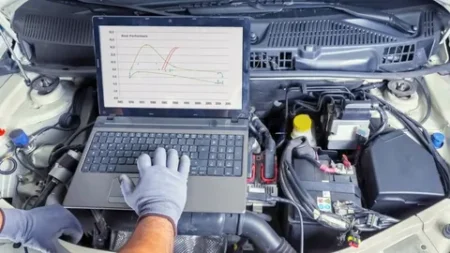Ever get the feeling your car isn’t quite giving you everything it’s got? You hit the gas, and it moves, sure, but it just doesn’t have that oomph you were hoping for. Here’s a secret: most engines leave the factory with a good amount of power still locked away. Automakers tend to prioritize safety, keeping emissions in check, and catering to average driving situations. So, excitement often takes a back seat.
The really great part is this untapped power is still there, waiting to be unleashed. And nowadays, you don’t need a full-blown mechanic shop to find it. A performance chip, or even a tuning chip, can really wake your car up in ways you’ll immediately notice. Think smoother acceleration, quicker response, and even better fuel economy in many cases. From my experience, the change can really be quite significant.
So, let’s dig into what these chips actually do, how they’re different, and which one might be the key to making your car feel brand new again.
Why Are Cars “Underpowered” from the Start?
Okay, first things first — car companies aren’t deliberately making slow cars. They’re making safe cars.
Engines need to work pretty much anywhere on the planet, from snowy mountain roads to hot, humid deserts. They also have to be able to run on different grades of fuel. To ensure everything keeps running smoothly, manufacturers tend to play it safe, dialing back the air-fuel mixture and limiting things like boost pressure and how sensitive the throttle is.
Basically, your car is capable of more, but it’s been programmed to be cautious. That’s where tuning devices, specifically performance and tuning chips, come into play.
Performance Chips: The Easy Power-Up
A performance chip is often one of the simplest and safest ways to get a real boost in your car’s performance without having to mess with the ECU software permanently.
These are usually small, easy-to-install modules that plug right into your car’s OBD2 port (or sometimes directly into engine sensors). Once it’s connected, it starts talking to your ECU, tweaking things like ignition timing, fuel delivery, and how fast the throttle responds – all in real time.
Think of it as a “little helper brain” for your car’s ECU, fine-tuning its decisions to give you more power and better efficiency.
Installation is usually a breeze. You don’t need a computer or any super-technical skills. Just plug it in, choose your driving mode (Eco, Sport, or Race, for example), and that’s it. And the best part? If you ever want to take it off, just unplug it, and your car goes right back to its original settings.
The perks of a performance chip:
- Super easy plug-and-play installation.
- Totally reversible and safe.
- No ECU flashing or complex tuning required.
- Works with both gas and diesel engines.
- Noticeable increase in power and throttle response.
For many drivers, it’s a great, no-fuss upgrade — real power, without the potential headache.
Tuning Chips: Taking It to the Next Level
Alright, now let’s get into tuning chips.
These are a bit more sophisticated than your average performance chip. Instead of just using pre-set settings, a tuning chip is always looking at live engine data – things like how far the throttle is open, how much air is coming in, turbo pressure, temperature, you name it. Then, it fine-tunes the performance as you drive.
What’s the result? Greater precision, more adaptability, and an overall smoother driving experience.
When you’re just cruising along, it optimizes for fuel efficiency. But when you put your foot down, it instantly adjusts to give you maximum power. It’s basically a “smart” chip that learns and adapts to your driving style and the conditions.
Some tuning chips even have their own built-in displays that show you things like torque, boost pressure, and how much power you’re gaining. Others let you make custom adjustments through menus, giving you the flexibility of a professional ECU tune without the risk or complexity.
Performance Chip vs. Tuning Chip: What’s the Real Difference?
Both of these upgrades will give you a performance boost, but the main difference is how they go about it.
A performance chip is more straightforward – it uses pre-programmed settings that are optimized for general performance and reliability. Plug it in, pick a mode, and you’re ready to go.
A tuning chip, on the other hand, is more interactive. It’s constantly adapting based on the engine’s feedback, which means it has the potential to give you slightly better results. Ultimately, it depends on what you’re looking for.
Alright, let’s dive into what you can realistically expect from a performance or tuning chip. Now, everyone wants to know the bottom line: horsepower. Depending on what you’re working with, a decent chip will give you:
- Turbocharged engines: 15–30% jump in horsepower and torque.
- Naturally aspirated engines: 5–10% bump in power and a snappier throttle.
- Diesel engines: 10–25% increase in torque, often with better fuel efficiency.
So, picture this — you’ve got a 200-horsepower turbocharged engine. Pop in a tuning chip, and bam, you’re potentially cruising with 240, maybe even 260 horsepower, and the torque curve gets a whole lot juicier too.
What’s great is not just the numbers. The whole driving experience changes. The car just feels better. The lag is gone. Shifts are smoother. You touch the pedal and it goes – it’s a blast, and honestly, hard to go back after you’ve tried it.
Hidden Benefits You Might Not Expect
There are some cool hidden benefits too, which you might find surprising. Things like better fuel economy. Lots of drivers notice maybe 10–15% better mileage, particularly if they’re using an Eco mode. That’s probably down to the engine running more efficiently.
And then you get smoother acceleration – the power delivery just feels more natural, less of that on-off feeling. Potentially reduced engine strain, too, because the fuel delivery is optimized.
The customizable factor is something else. Being able to switch between Eco, Sport, or Race mode – it’s like having several cars in one.
But here’s a note of caution: not all chips are created equal. You will see those super cheap “miracle” chips advertised online. I wouldn’t bother. Those are generally just resistors tricking the sensors. They won’t actually improve anything and could even throw up a check engine light or worse, damage the electrics.
Monte Tuning: Power You Can Trust
When it comes to chips, it’s best practice to stick with reputable manufacturers — companies that test and warranty their products.
Monte Tuning is one of those brands, and they have a couple of popular options.
There’s the Monte GT, which is pretty much plug-and-play for better throttle response and power, offering Eco, Sport, and Race modes and suitable for both gas and diesel engines. It’s also designed to be safe within factory settings and fully reversible, so you can go back to your original setup anytime you want.
Then there’s the Monte GTR, which is for those who want more control. It has live data monitoring, a built-in display, and can read and clear OBD2 codes. It also lets you monitor torque and boost in real time, which is a fantastic tool for performance tuning and safety on the street.
Both options come with a lifetime warranty and a 30-day guarantee, showing Monte Tuning truly stands behind their products.
Final Thoughts
For my money, both chips give you a way to tap into your car’s hidden potential. Me? I’m a hands-on kind of guy, so I’d probably go for the tuning chip. But if you want simple and reliable, the performance chip will do the trick.
Regardless, you’ll get better throttle response, smoother acceleration, and a car that feels more alive. Modern cars are built with limitations, sure, but with a quality chip, you can explore those limits without risking your engine.
Ever wonder what your ride is truly capable of? Honestly, the best place to start is with the right performance chip – and believe me, you will feel the difference. Getting that perfect upgrade can really unleash some hidden power, and that’s pretty exciting, don’t you think?



